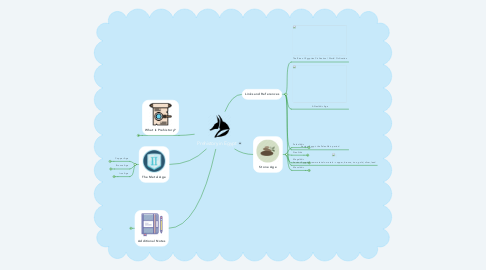
1. What Is Prehistory?
1.1. Prehistory is a time before civilization. in that time since humankind hasn't written much, that is why we don't know much about them, but we know some information about them due to archaeologist doing their job and excavating sites
2. The Metal Age
2.1. Copper Age
2.1.1. Copper is a soft, malleable, and ductile metal with very high thermal and electrical conductivity. A freshly exposed surface of pure copper has a pinkish-orange color
2.1.1.1. Until The New Kingdom, Egyptians used copper mind from the Sinai. The oldest Copper Artifacts that were found were Beads and small tools that dated back to the 4th Millennium. Some had proposed that they were Native Copper that could occasionally be found, others say that the Copper extracted from Malachite, Hydrated Copper Carbonate.
2.2. Bronze Age
2.2.1. Bronze is an alloy of Copper and 4% tin. It's harder than Pure Copper but melts at a lower temperature and is easier to cast
2.2.1.1. When Bronze was introduced to the Egyptians, it had a huge improvement to the manufacturing of tools. The manufacturing process of Bronze was similar to the Manufacturing of Copper: It could be cast, hammered cold, and annealing improved its toughness.
2.2.1.1.1. When Bronze was introduced to the Egyptians, it had a huge improvement to the manufacturing of tools. The manufacturing process of Bronze was similar to the Manufacturing of Copper: It could be cast, hammered cold, and annealing improved its toughness.
2.3. Iron Age
2.3.1. Iron is a common element that occurs in the mountainous area of the Sinai.
2.3.1.1. Much of the Iron was used for Tool and Weapon making and were therefore Imported. The place that became the great place for Iron Manufacturing was Naukratis and Defenneh. Iron, while the most utilitarian of metals, was still employed to fashion ornaments, but it was most important for making knives, the only metal tools most of humanity ever used and owned until the industrial revolution.
3. Additional Notes
3.1. The Sinai
3.1.1. Egypt’s Sinai Peninsula is a sparsely populated desert region between the Red Sea and the Mediterranean Sea.
3.2. Religion
3.2.1. It wasn't that much known of what the Religion of Prehistoric Egypt, but we do know its deities today as they believed in many things as in the God Ra, Amun or Amun-Ra, the god(s) of The Sun and The Wind, Nun The primeval God, Hathor The Cow Goddess, Maat the Goddess Of Order, Bastet or Sekhmet the Feline Goddess. Isis, The Magic Goddess, Horus The Falcon God, Osiris The dead God, Set The antagonist god, Ptah The Creator God and Anubis the Jackal God and Etc.
3.3. Myths
3.3.1. There are many myths about the Creation that the Ancient Egyptians and here are to list a few of the Myths: The Creation Myth, The cycle of the sun (which might be more of a legend), The Creation of Sekhmet (The feline Goddess and (probably) the War Goddess, The death of Osiris and many more.
4. Stone Age
4.1. Paleolithic
4.1.1. relating to or denoting the early phase of the Stone Age, lasting about 2.5 million years, when primitive stone implements were used.
4.1.1.1. The Paleolithic era was the first and earliest period that Egypt had human activity. Instead of a desert the land was lush with plants and greenery, people lived near the Nile river, Lake Sameera, Lake Mareotis/Moeris, and etc. tools were made of Stone ans the Egyptians subsisted on Hunting, Farming, and Gathering.
4.2. Neolithic
4.2.1. Relating to or denoting the later part of the Stone Age, when ground or Polished Stone Weapons and implements prevailed.
4.2.1.1. The Neolithic period was a big impact for the Egyptians as The Nile River provided the people for Agriculture and a barrier for diseases and attacks. The Egyptians created early geometry for their canals and boats. the agriculture efficiency increased and there was also a decline in farmers, people who weren't farming became Artisans, Traders, Merchants, etc.
4.3. Megalithic
4.3.1. Relating to or denoting Prehistoric monuments made of or containing Megaliths.
4.3.1.1. About 11,000 Years ago, people from Central Africa moved to Egypt and made temporary Lakes and Playas. There has been findings of Stone Circles and Megalithic Alignment next to middle and Neolithic communities. This is a Megalithic Astronomy for Egypt.
4.4. Mesolithic
4.4.1. Relating to or denoting the middle part of the Stone Age, between the Paleolithic and Neolithic.
4.4.1.1. The Mesolithic Egyptians had Halfan Culture that arose near the Nile River between 18,000 to 15,000 BC. these people seem to be descended from the Khormusan people, there was also the Qadan Culture where people practiced wild grain harvesting near The Nile River, and created sickles and grinding stone as a part of this process.
4.4.1.1.1. These people were likely residents of Libya and who were pushed to the Nile Valley due to desiccation in the Sahara. The Sebilian culture (also known as Esna) gathered wheat and barley. There was also the Harfian culture that migrated out of Fayyum and eastern Egypt to merge with Pre-Pottery.

